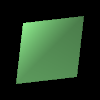normal()#
Sets the current normal vector.
Examples#

def setup():
py5.size(100, 100, py5.P3D)
py5.no_stroke()
py5.background(0)
py5.point_light(150, 250, 150, 10, 30, 50)
py5.begin_shape()
py5.normal(0, 0, 1)
py5.vertex(20, 20, -10)
py5.vertex(80, 20, 10)
py5.vertex(80, 80, -10)
py5.vertex(20, 80, 10)
py5.end_shape(py5.CLOSE)
Description#
Sets the current normal vector. Used for drawing three dimensional shapes and surfaces, normal() specifies a vector perpendicular to a shape’s surface which, in turn, determines how lighting affects it. Py5 attempts to automatically assign normals to shapes, but since that’s imperfect, this is a better option when you want more control. This function is identical to gl_normal3f() in OpenGL.
Underlying Processing method: normal
Signatures#
normal(
nx: float, # x direction
ny: float, # y direction
nz: float, # z direction
/,
) -> None
Updated on March 06, 2023 02:49:26am UTC
